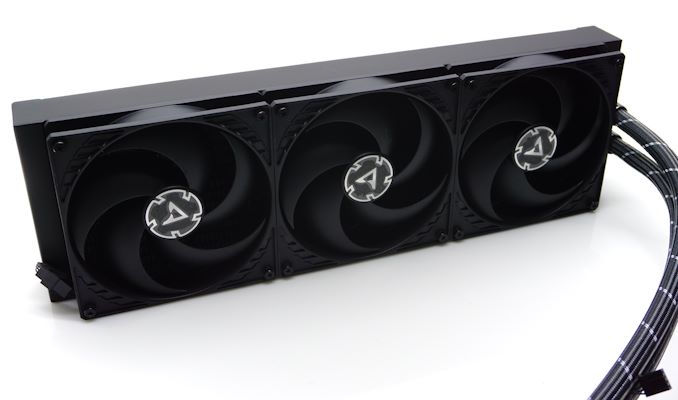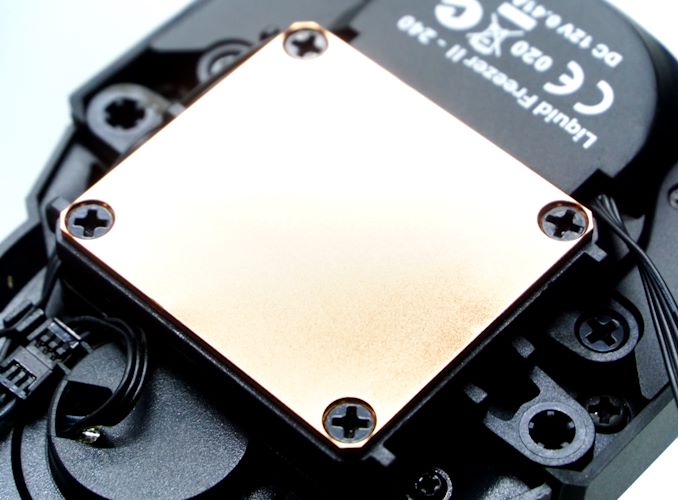The Arctic Cooling Liquid Freezer II 240 & 420 AIO Coolers Review: Big and Effective
by E. Fylladitakis on January 15, 2021 8:15 AM EST- Posted in
- Cases/Cooling/PSUs
- Corsair
- Water Cooling
- Liquid Cooling
Conclusion
Arctic Cooling designed the Liquid Freezer II series of all-in-one coolers for users who value subtle designs and seek a good price-to-performance ratio. The series currently consists of five coolers, ranging from a small single 120 mm version to the massive three 140 mm fans version that we reviewed today. All share the same main block and tubing, making the choice of radiator more of a compatibility matter than anything else.
Although they look very simple at first glance, the Liquid Freezer II coolers actually are niftily designed. They combine quality and elegance in an ingenious way rather than relying on colorful lighting to draw attention. The designer’s idea to incorporate the wiring of the fans into the cooler has several advantages, including quicker installation and a very clean appearance once installed. Our only worry lies with using the triple-fan models with low-end motherboards, as it's possible that the power circuitry of the motherboard may be overloaded by the entirety of the cooler’s power needs. Then again, there probably aren't too many builders and PC enthusiasts installing such a massive liquid cooler on a low-end motherboard to begin with.
In terms of performance, the Liquid Freezer II produces very good results. Their thermal performance seems to be excellent, with the cooler that we have tested outperforming similarly-sized competitors. Most of that advantage comes from the radiators, which do offer better heat exchange rates but, on the other hand, their thickness absolutely needs to be taken into account when determining if the cooler is compatible with a given case/system. Meanwhile, the acoustics performance of the Liquid Freezer II coolers is somewhat worse compared to that of similar offerings, with the small 40 mm fan on the main block being mostly to blame for these results. Nevertheless, the coolers are not actually loud or intrusive and most users would probably welcome the additional cooling for the motherboard’s vital power components.
Arctic Cooling is a company that typically designs practical, ‘no-frills’ products, aiming to perform reliably and retail at a reasonable cost. The Liquid Freezer II AIO coolers are no exception, as they are sporting a subtle design and offer excellent overall performance at a very reasonable price tag: the 240 model sells for just under $100, and even the mammoth 420 model is only $160 – at least if you can find it in stock.
Ultimately, If you are seeking to purchase a high-performance cooler and do not care about RGB lighting or other aesthetic features, the Liquid Freezer II coolers are equally capable products that retail at a significantly lower retail price than most of the competition and should definitely be on your shortlist for consideration.












44 Comments
View All Comments
jabber - Saturday, January 16, 2021 - link
Hmm interesting. I just this week replaced my Arctic Cooling 240 MK1 AIO with a Noctua NH-D15S. The result was pretty much the same cooling but about 60% less noise. A success in my book. Nice easy installation too. The only change was I used my Grizzly paste rather then the tube of Noctua supplied.Makaveli - Saturday, January 16, 2021 - link
I've not had any noise issues at all on a Corsair H150i 60% less noise with a D15S? sounds like that AC 240MK1 AIO is junk.jabber - Sunday, January 17, 2021 - link
4x120mm fans on the AC AIO down to 1x140mm fan on the Noctua. Not hard to imagine really.The 60% is not a measured figure, shall we say "a lot quieter!"
Makaveli - Sunday, January 17, 2021 - link
Except the AC240MK1 is a 240MM AIO which means 2x120mm Fans. He never said he has the 420mm model which is what you are using for an example in your post. Nice try though.jabber - Sunday, January 17, 2021 - link
In that case I have the version with 4 120 fans. The Artic Liqid Freezer 240 with 4 fans.https://www.kitguru.net/components/cooling/dominic...
So yeah, nice try.
Makaveli - Monday, January 18, 2021 - link
I wouldn't expect a 4 fan 120mm AIO to be quiet. A 3 fan 140mm AIO would make less noise than that.brontes - Saturday, January 16, 2021 - link
I'm not sure about non-PC radiators but in the PC space, crossflow (or "xflow") refer to rads that have the inlet and outlet on opposite ends. This is single pass. While less performant than dual pass, it's not as bad as you'd expect as it's much less restrictive and will yield a higher flow rate at a given pump speed(/noise level.) The primary use case is for cleaner/less tubing, depending on the case layout.The alternative is your standard dual pass where the water runs to one end, turns around, and runs across the rad again. Inlet and outlet are on the same end.
At least in the PC realm of parlance, there is no such thing as a "dual-pass cross-flow design."
micoequipment - Monday, January 18, 2021 - link
Great Awesome blog. It's so informative and I love this type of blog and articles.Tom Sunday - Tuesday, January 19, 2021 - link
Yes there is lot to glean from blogs and the feelings of the many. But also a lot o read between the lines and simply cutting through the minutiae. I am just amazed that the AIO manufactures have not come up with any 'new products' and just adding lighting, better hoses, pump head configurations, etc. Todays AIO's are far from where they should be.Oxford Guy - Tuesday, January 19, 2021 - link
Be specific. What do you think they’re lacking?My view is that they’re being applied to the wrong thing. GPUs need them far more than an efficient CPU like recent Zen.